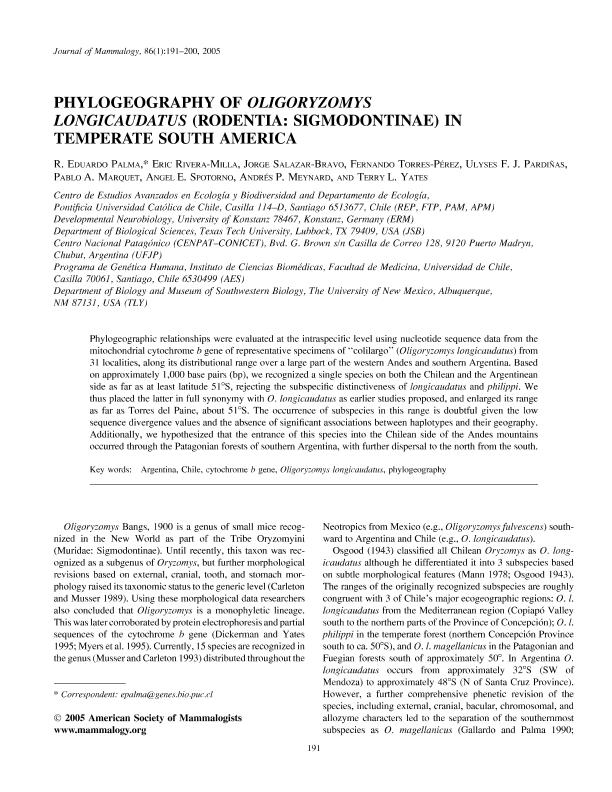Artículo
Phylogeography of Oligoryzomys longicaudatus (Rodentia: Sigmodontinae) in Temperate South America
Palma, R. Eduardo; Rivera Milla, Eric; Salazar Bravo, Jorge; Torres Pérez, Fernando; Pardiñas, Ulises Francisco J. ; Marquet Iturriaga, Pablo Angel; Spotorno, Angel E.; Meynard, Andrés P.; Yates, Terry L.
; Marquet Iturriaga, Pablo Angel; Spotorno, Angel E.; Meynard, Andrés P.; Yates, Terry L.
 ; Marquet Iturriaga, Pablo Angel; Spotorno, Angel E.; Meynard, Andrés P.; Yates, Terry L.
; Marquet Iturriaga, Pablo Angel; Spotorno, Angel E.; Meynard, Andrés P.; Yates, Terry L.
Fecha de publicación:
02/2005
Editorial:
Oxford University Press
Revista:
Journal of Mammalogy
ISSN:
0022-2372
Idioma:
Inglés
Tipo de recurso:
Artículo publicado
Clasificación temática:
Resumen
Phylogeographic relationships were evaluated at the intraspecific level using nucleotide sequence data from the mitochondrial cytochrome b gene of representative specimens of ‘‘colilargo’’ (Oligoryzomys longicaudatus) from 31 localities, along its distributional range over a large part of the western Andes and southern Argentina. Based on approximately 1,000 base pairs (bp), we recognized a single species on both the Chilean and the Argentinean side as far as at least latitude 518S, rejecting the subspecific distinctiveness of longicaudatus and philippi. We thus placed the latter in full synonymy with O. longicaudatus as earlier studies proposed, and enlarged its range as far as Torres del Paine, about 518S. The occurrence of subspecies in this range is doubtful given the low sequence divergence values and the absence of significant associations between haplotypes and their geography. Additionally, we hypothesized that the entrance of this species into the Chilean side of the Andes mountains occurred through the Patagonian forests of southern Argentina, with further dispersal to the north from the south.b gene of representative specimens of ‘‘colilargo’’ (Oligoryzomys longicaudatus) from 31 localities, along its distributional range over a large part of the western Andes and southern Argentina. Based on approximately 1,000 base pairs (bp), we recognized a single species on both the Chilean and the Argentinean side as far as at least latitude 518S, rejecting the subspecific distinctiveness of longicaudatus and philippi. We thus placed the latter in full synonymy with O. longicaudatus as earlier studies proposed, and enlarged its range as far as Torres del Paine, about 518S. The occurrence of subspecies in this range is doubtful given the low sequence divergence values and the absence of significant associations between haplotypes and their geography. Additionally, we hypothesized that the entrance of this species into the Chilean side of the Andes mountains occurred through the Patagonian forests of southern Argentina, with further dispersal to the north from the south.
Palabras clave:
ARGENTINA
,
CHILE
,
CYTOCHROME B GENE
,
OLIGORYZOMYS LONGICAUDATUS
,
PHYLOGEOGRAPHY
Archivos asociados
Licencia
Identificadores
Colecciones
Articulos(CCT-CENPAT)
Articulos de CTRO.CIENTIFICO TECNOL.CONICET - CENPAT
Articulos de CTRO.CIENTIFICO TECNOL.CONICET - CENPAT
Citación
Palma, R. Eduardo; Rivera Milla, Eric; Salazar Bravo, Jorge; Torres Pérez, Fernando; Pardiñas, Ulises Francisco J.; et al.; Phylogeography of Oligoryzomys longicaudatus (Rodentia: Sigmodontinae) in Temperate South America; Oxford University Press; Journal of Mammalogy; 86; 1; 2-2005; 191-200
Compartir
Altmétricas



